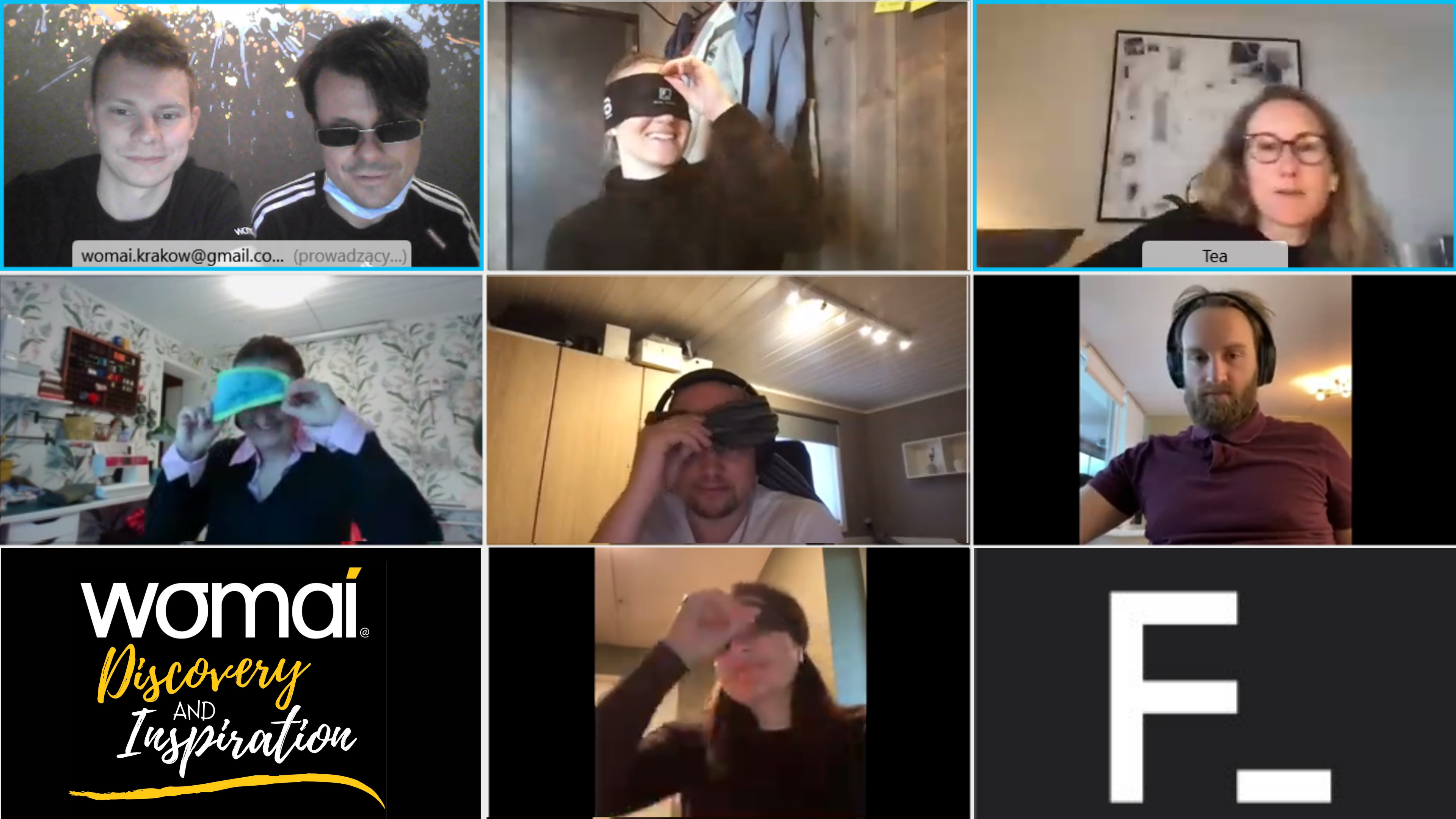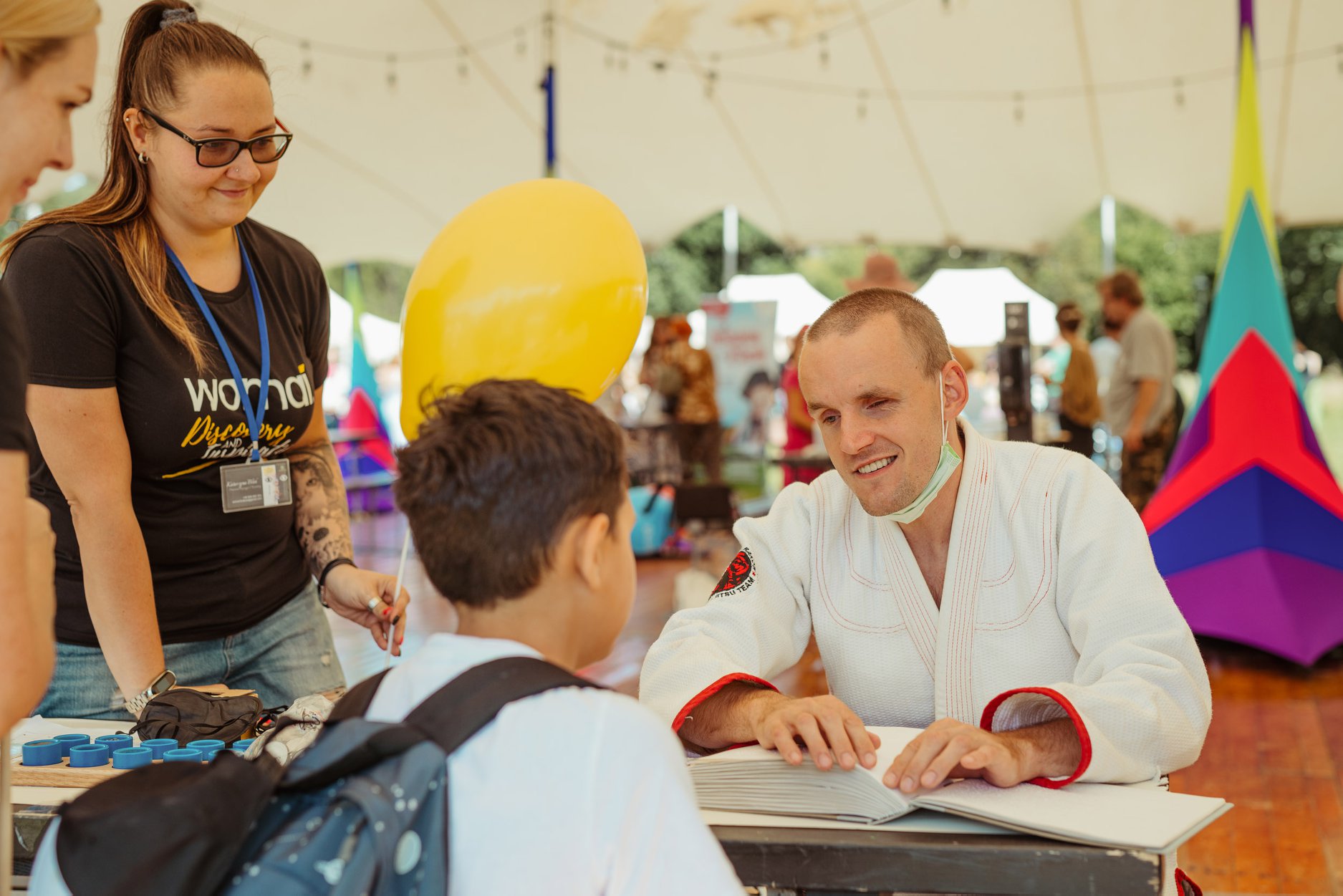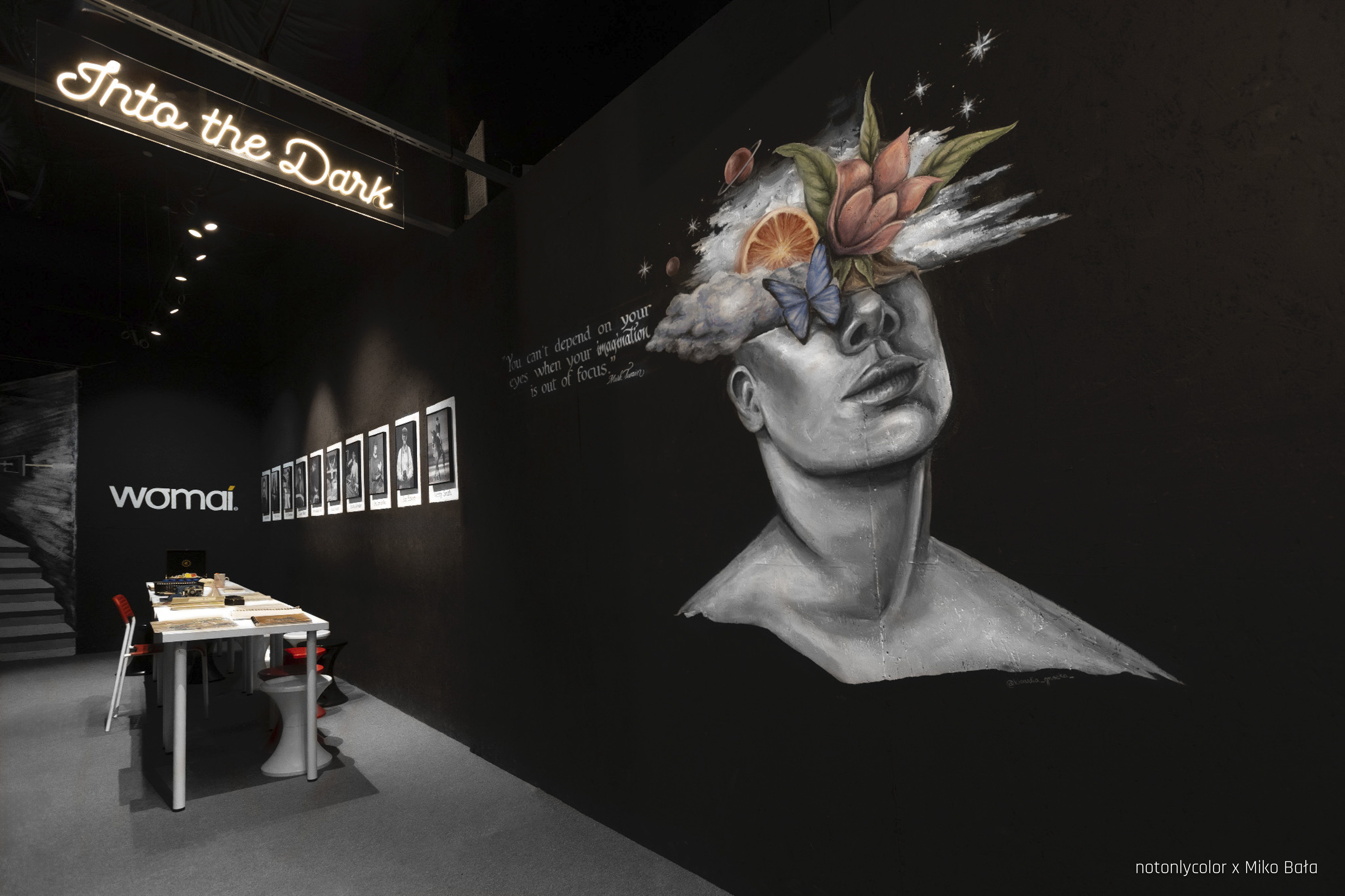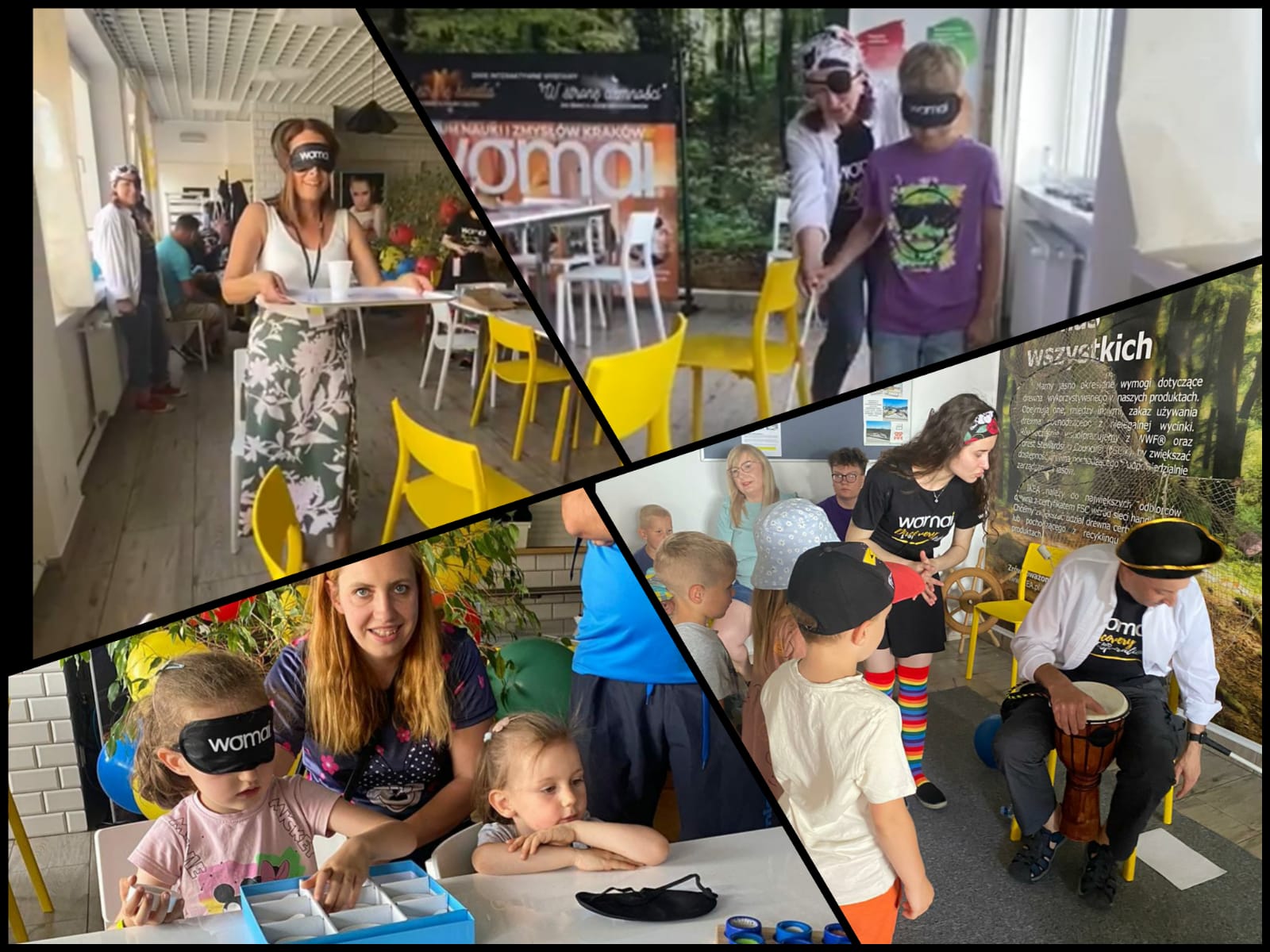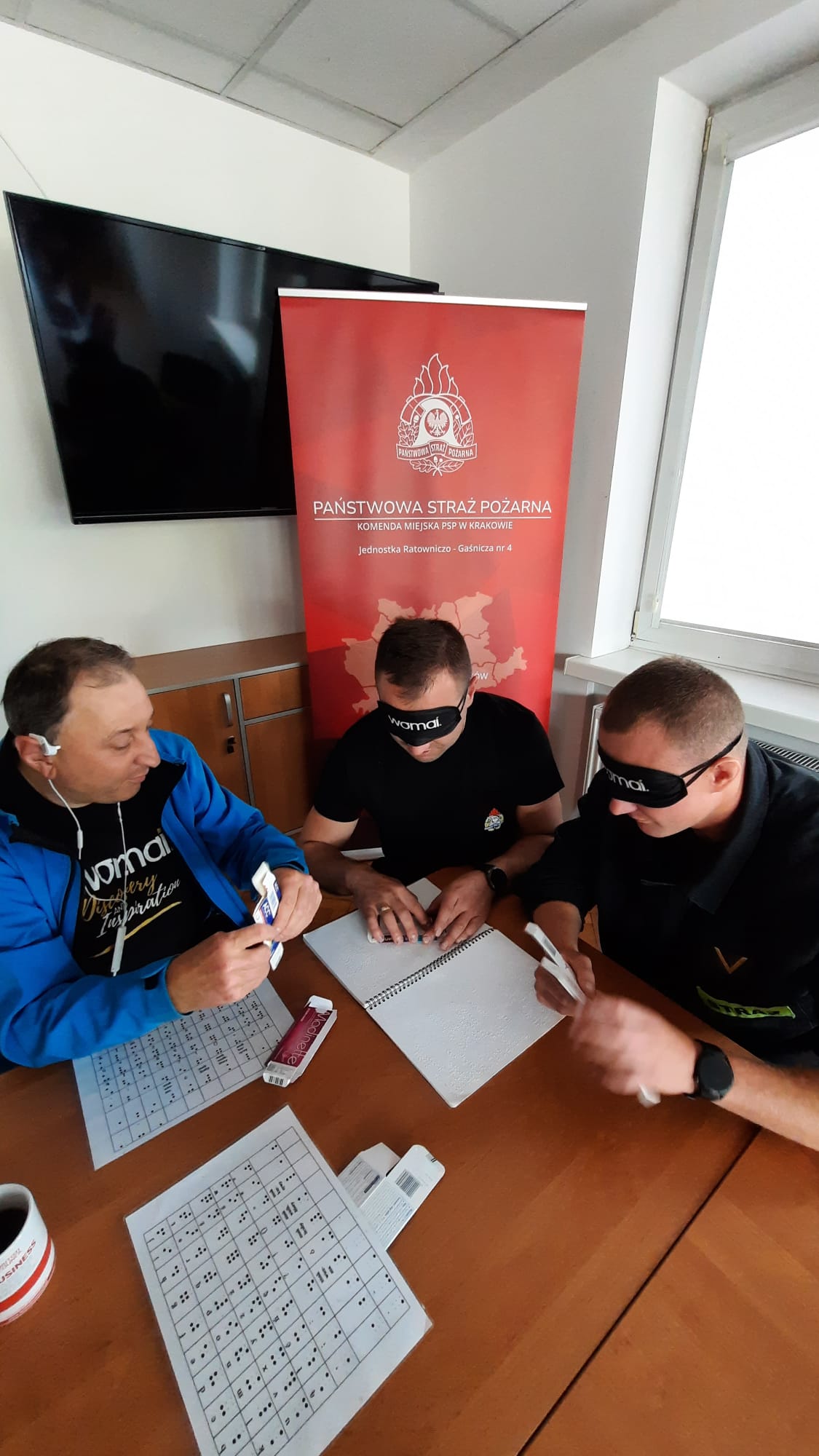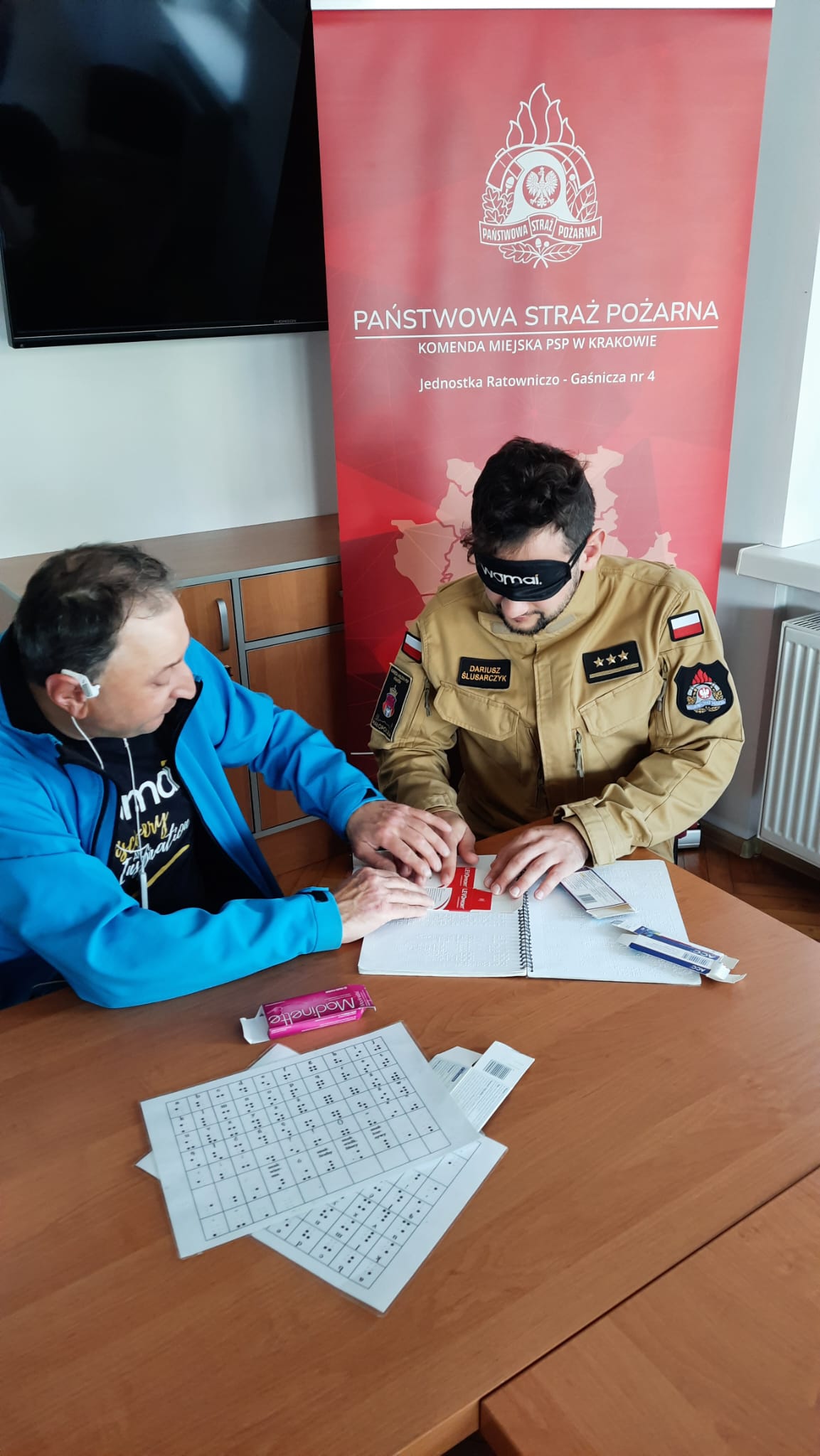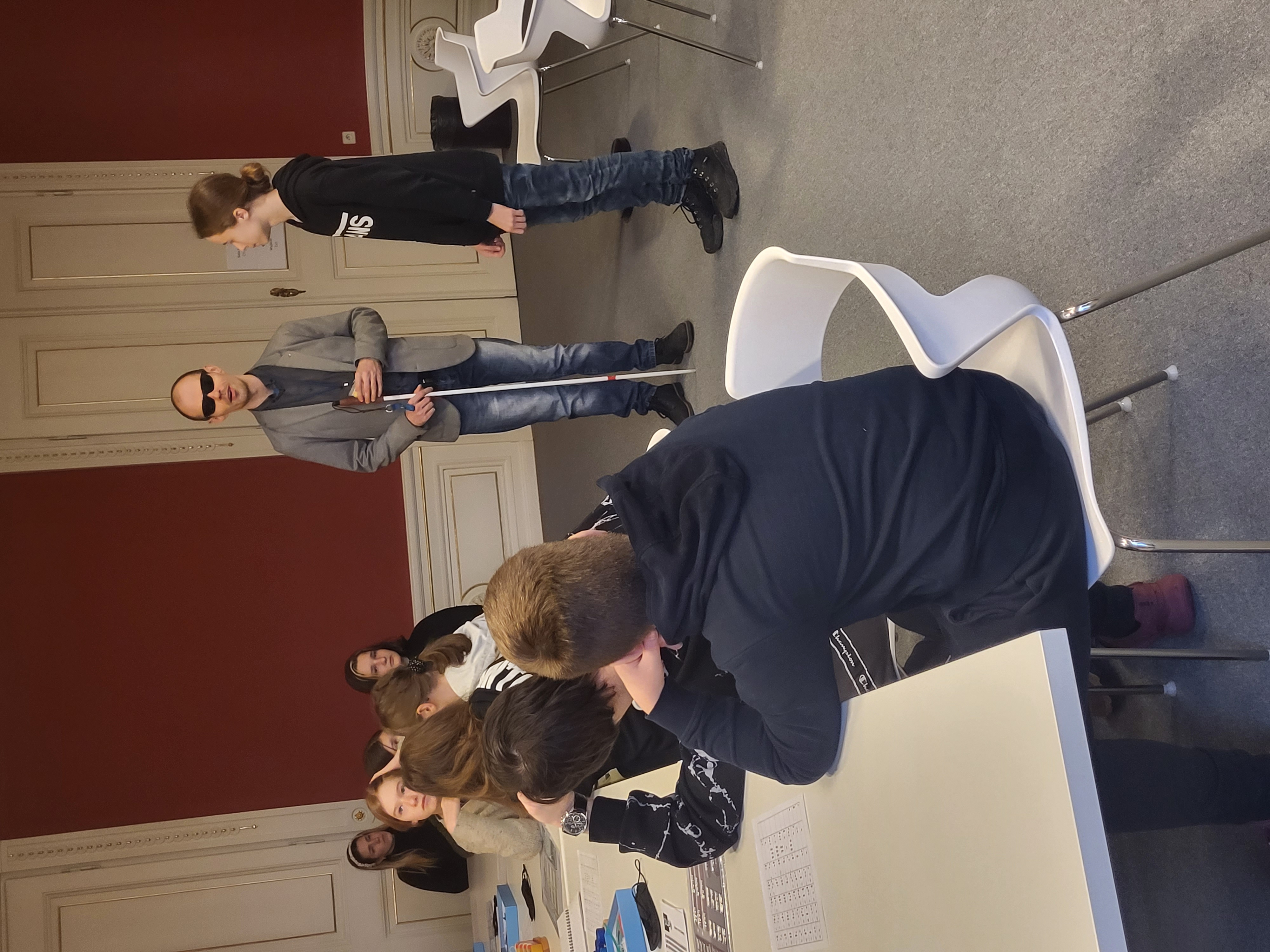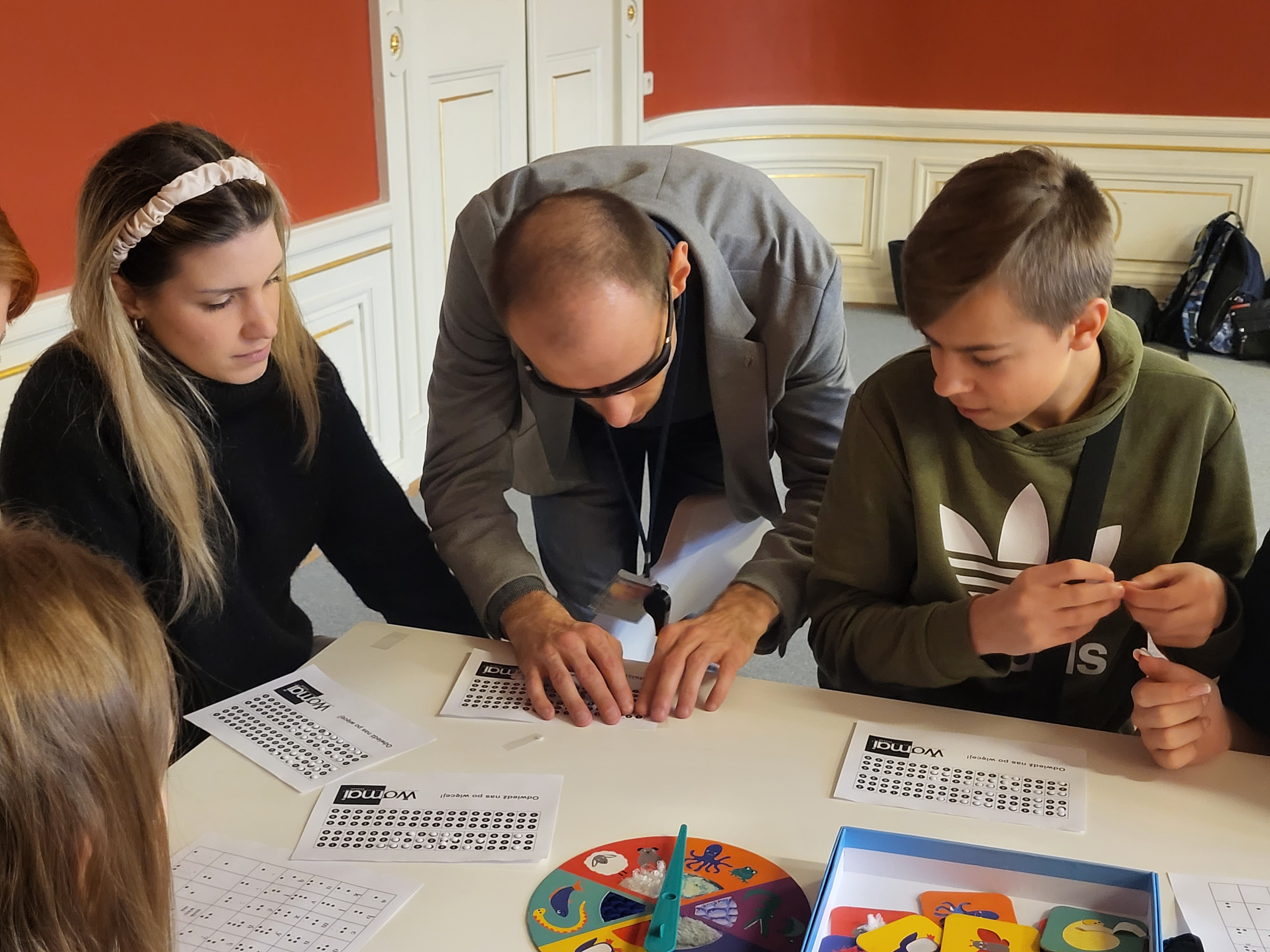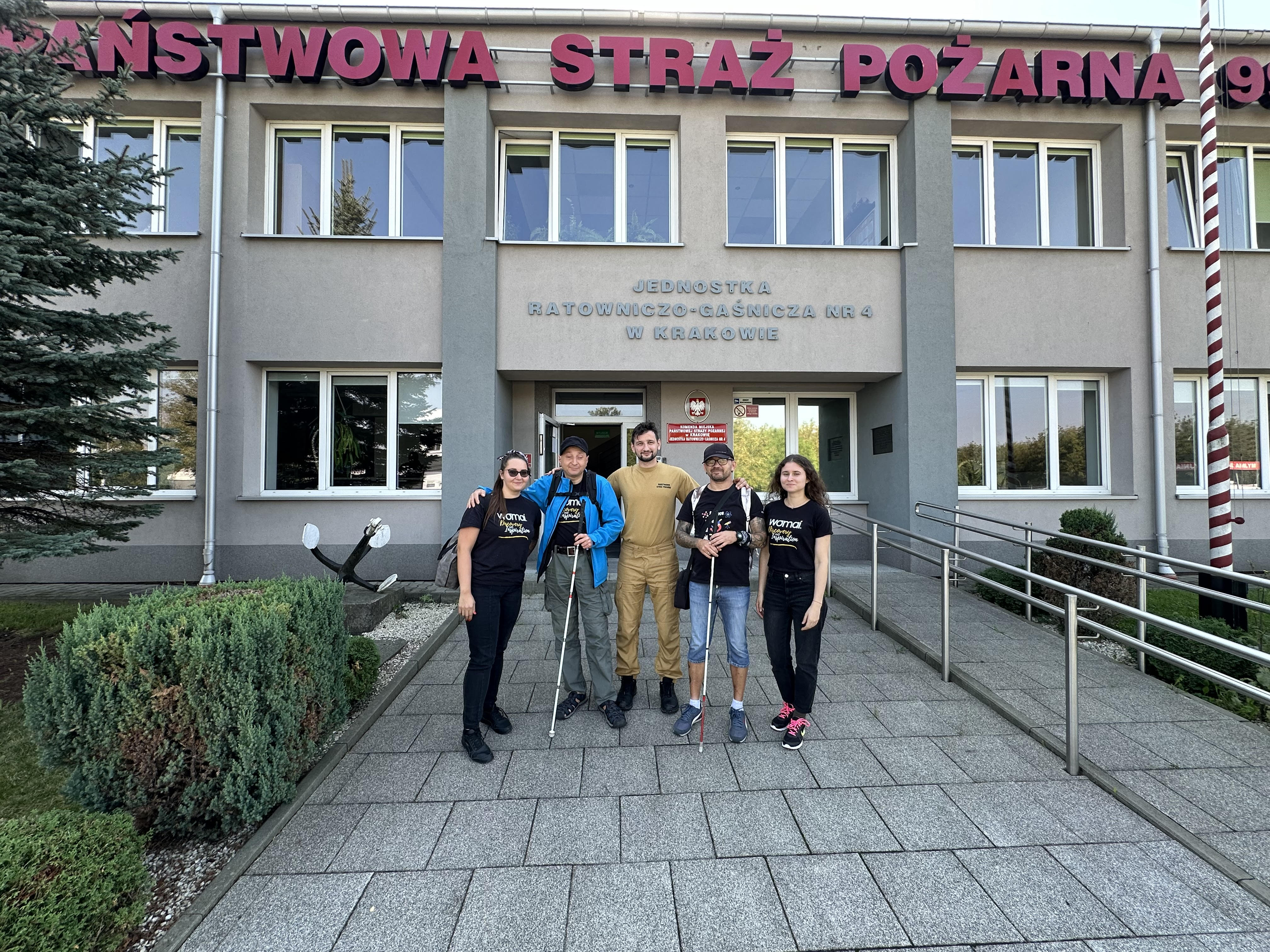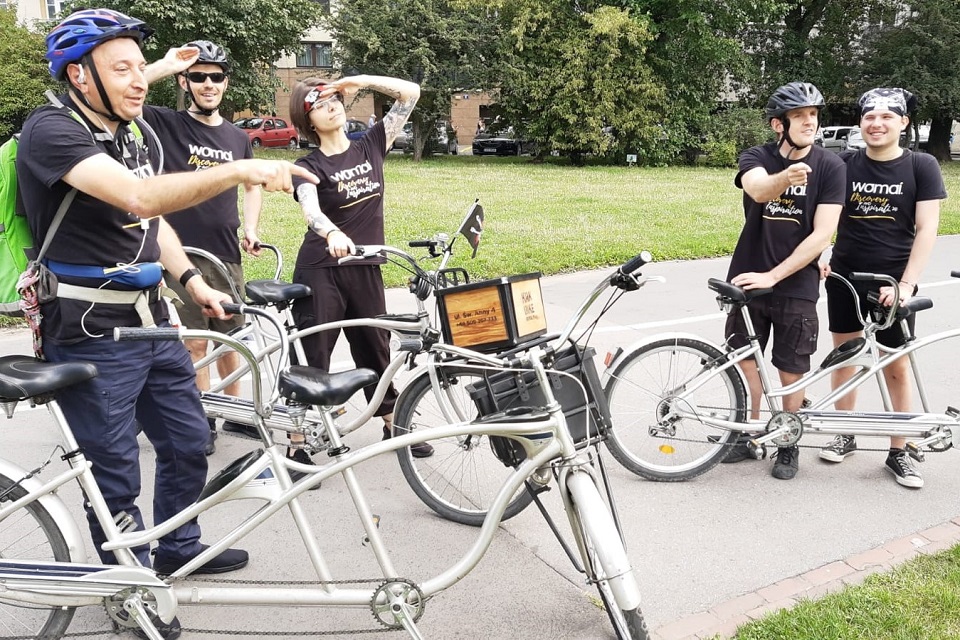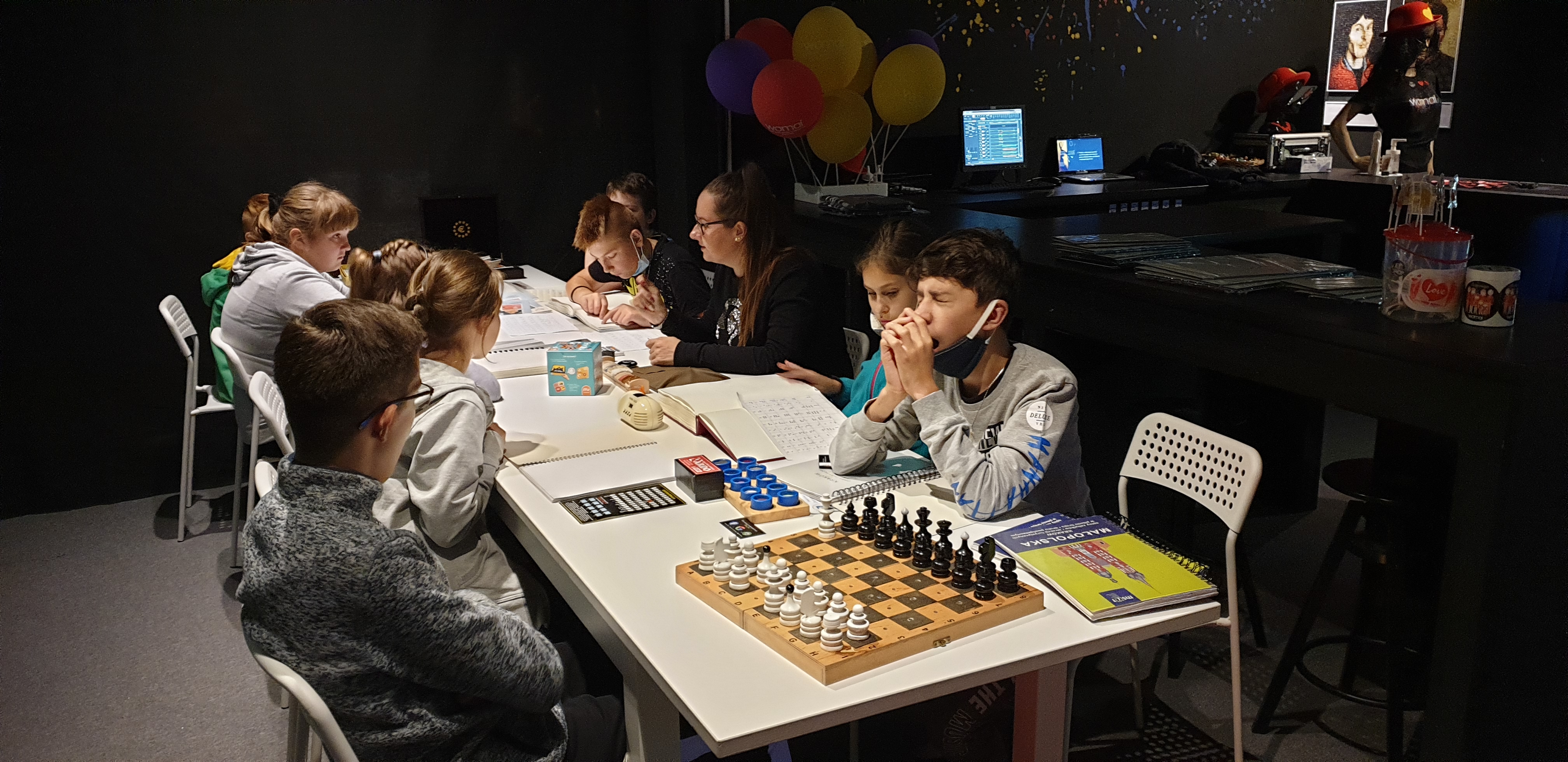Regaining a sense of belonging
Exhibition "into the darkness"
Exhibition "into the darkness" at the WOMAI Center of Science and Senses
Into the Darkness is a unique, interactive project at the WOMAI Center, created and led by blind individuals. It fosters empathy, highlights inclusivity, and showcases the value of diversity. Through full immersion in darkness, participants discover the world in a new way, developing sensitivity and new perspectives. At the same time, they gain insight into the needs of people with disabilities, broadening their understanding of their role in society.
Poland
Local
Krakow Lesser Poland
It addresses urban-rural linkages
It refers to other types of transformations (soft investment)
Yes
2019-10-01
No
No
No
As a representative of an organisation
Into the Darkness is a unique interactive project at the WOMAI Center that cultivates empathy, promotes integration and celebrates the value of diversity. Participants enter total darkness for 50 minutes, led by a blind guide, immersing themselves in an environment where sight is no longer possible. Instead, they navigate everyday situations through touch, sound and smell, discovering a world rich in sensory details but often unnoticed.
As they go through the experience, participants encounter not only new challenges, but also deeply personal and inspiring stories told by their guides – real people who live without sight. These first-hand accounts provide a powerful dose of emotion, encourage reflection and inspire open-mindedness. At the end of the journey, participants gain a deeper understanding of the needs of people with disabilities and the importance of integration.
Target groups: • People with visual impairments and their families – better understanding and sharing of experiences. • Children and young people – education about visual impairment. • Students – raising awareness about the needs of people with disabilities in the future of work. • Adults – developing empathy, openness and providing unforgettable experiences. • Seniors – emphasizing the value of diversity and social activity.
Specific objectives: • Enabling the experience of the world of blind people. • Educating about their challenges. • Shaping attitudes based on empathy and integration. • Promoting the inclusion of disabled people in social and professional life. • Emphasizing the value of each individual for society.
Results: • Increasing awareness and inclusion of blind people in society. • Increasing empathy and openness. • Intergenerational integration. • Strengthening the sense of community and the value of diversity.
The “Into the Darkness” project combines education with experience, inspiring reflection on the power that diversity brings.
As they go through the experience, participants encounter not only new challenges, but also deeply personal and inspiring stories told by their guides – real people who live without sight. These first-hand accounts provide a powerful dose of emotion, encourage reflection and inspire open-mindedness. At the end of the journey, participants gain a deeper understanding of the needs of people with disabilities and the importance of integration.
Target groups: • People with visual impairments and their families – better understanding and sharing of experiences. • Children and young people – education about visual impairment. • Students – raising awareness about the needs of people with disabilities in the future of work. • Adults – developing empathy, openness and providing unforgettable experiences. • Seniors – emphasizing the value of diversity and social activity.
Specific objectives: • Enabling the experience of the world of blind people. • Educating about their challenges. • Shaping attitudes based on empathy and integration. • Promoting the inclusion of disabled people in social and professional life. • Emphasizing the value of each individual for society.
Results: • Increasing awareness and inclusion of blind people in society. • Increasing empathy and openness. • Intergenerational integration. • Strengthening the sense of community and the value of diversity.
The “Into the Darkness” project combines education with experience, inspiring reflection on the power that diversity brings.
Diversity
Inclusion
Experience
Inspiration
Integration
The Into the Darkness project at the WOMAI Center for Science and Senses aligns with the values of the New European Bauhaus, combining beauty, sustainability, and inclusion in a unique experience.
Beauty in this project goes beyond sight-based perception. The exhibition proves that the world remains beautiful and valuable even for those with sensory limitations. Through sound, touch, scent, and emotion, participants discover new ways of experiencing reality, broadening their understanding of the world.
Sustainability is fostered through education and awareness, encouraging reflection on diverse ways of perceiving the world. The project promotes empathy and conscious design of inclusive spaces.
Inclusion is at its core—blind guides lead visitors, sharing their unique perspective and teaching a new way of experiencing reality. This creates an authentic dialogue and breaks down social barriers. The project also supports the professional activation of blind individuals by offering employment.
A Model of Sustainable Development
The Into the Darkness project exemplifies sustainable development by integrating education, inclusion, and social awareness.
Key Goals:
Education & Awareness – Participants navigate complete darkness, reshaping their perception. Interactive elements demonstrate how different senses compensate for the lack of sight.
Inclusion & Professional Activation – Blind individuals serve as guides, challenging stereotypes while creating real employment opportunities and strengthening their role in society.
Conscious Perception – The experience highlights how the world is perceived through multiple senses, encouraging mindfulness and reflection.
A Benchmark for Innovation
Projekt successfully integrates education, social engagement, and culture, inspiring a more empathetic and conscious world. It showcases how innovation can drive real change, promoting inclusion and sustainable development.
Beauty in this project goes beyond sight-based perception. The exhibition proves that the world remains beautiful and valuable even for those with sensory limitations. Through sound, touch, scent, and emotion, participants discover new ways of experiencing reality, broadening their understanding of the world.
Sustainability is fostered through education and awareness, encouraging reflection on diverse ways of perceiving the world. The project promotes empathy and conscious design of inclusive spaces.
Inclusion is at its core—blind guides lead visitors, sharing their unique perspective and teaching a new way of experiencing reality. This creates an authentic dialogue and breaks down social barriers. The project also supports the professional activation of blind individuals by offering employment.
A Model of Sustainable Development
The Into the Darkness project exemplifies sustainable development by integrating education, inclusion, and social awareness.
Key Goals:
Education & Awareness – Participants navigate complete darkness, reshaping their perception. Interactive elements demonstrate how different senses compensate for the lack of sight.
Inclusion & Professional Activation – Blind individuals serve as guides, challenging stereotypes while creating real employment opportunities and strengthening their role in society.
Conscious Perception – The experience highlights how the world is perceived through multiple senses, encouraging mindfulness and reflection.
A Benchmark for Innovation
Projekt successfully integrates education, social engagement, and culture, inspiring a more empathetic and conscious world. It showcases how innovation can drive real change, promoting inclusion and sustainable development.
The Into the Darkness project at the WOMAI Center for Science and Senses offers a unique, multi-sensory aesthetic experience that goes beyond traditional forms of perception. The key goals related to aesthetics and the quality of experience include:
1. Experiencing Aesthetics Beyond Sight
The project engages senses other than sight—sound, touch, and scent—creating a space where participants discover beauty beyond traditional perception. Darkness, as the central element of the exhibition, transforms the way the environment is perceived and reveals that aesthetics can be experienced through senses other than vision. The project fosters sensitivity to the world, demonstrating that beauty can be felt through touch and sound.
2. Culture in Darkness – Turning Limitations into New Possibilities
Darkness, often seen as a limitation, becomes a creative space where participants learn to recognize beauty and value through other senses. Through interactive experiences such as sounds and textures, visitors explore new sensory dimensions of reality. The project reshapes the perception of art and culture, opening up new ways of aesthetic appreciation.
3. Integration of Art and Education
Into the Darkness is also an educational project that merges art with the science of sensory perception. Participants learn how sensory experiences shape their understanding of the world. The presence of blind guides enriches the experience, demonstrating how different forms of perception can lead to a deeper appreciation of culture and aesthetics.
The Into the Darkness project is an innovative approach to aesthetics, combining education and inclusion. It breaks the boundaries of traditional perception, engaging participants on multiple sensory levels. It serves as an example of how a project can inspire aesthetic sensitivity and create cultural value accessible to a wide audience
1. Experiencing Aesthetics Beyond Sight
The project engages senses other than sight—sound, touch, and scent—creating a space where participants discover beauty beyond traditional perception. Darkness, as the central element of the exhibition, transforms the way the environment is perceived and reveals that aesthetics can be experienced through senses other than vision. The project fosters sensitivity to the world, demonstrating that beauty can be felt through touch and sound.
2. Culture in Darkness – Turning Limitations into New Possibilities
Darkness, often seen as a limitation, becomes a creative space where participants learn to recognize beauty and value through other senses. Through interactive experiences such as sounds and textures, visitors explore new sensory dimensions of reality. The project reshapes the perception of art and culture, opening up new ways of aesthetic appreciation.
3. Integration of Art and Education
Into the Darkness is also an educational project that merges art with the science of sensory perception. Participants learn how sensory experiences shape their understanding of the world. The presence of blind guides enriches the experience, demonstrating how different forms of perception can lead to a deeper appreciation of culture and aesthetics.
The Into the Darkness project is an innovative approach to aesthetics, combining education and inclusion. It breaks the boundaries of traditional perception, engaging participants on multiple sensory levels. It serves as an example of how a project can inspire aesthetic sensitivity and create cultural value accessible to a wide audience
The Into the Darkness project exemplifies the principles of inclusivity, striving to create a space that is accessible and fosters social inclusion. The key goals include:
1. Accessibility and Affordability
The exhibition is available at affordable prices, with discounts and free entry options for people with disabilities and groups with limited financial resources, such as children from Ukraine during the war. Additionally, the project regularly hosts groups free of charge, providing valuable experiences and ensuring participation for those who lack financial means.
2. Designing Spaces and Experiences for Everyone
The exhibition is accessible to diverse groups and a broad audience from various backgrounds. By applying universal design principles, the experience remains engaging and inclusive, regardless of physical or sensory limitations.
3. Social Inclusion and Professional Activation
The project employs blind individuals as guides, offering them real career opportunities and breaking stereotypes. This approach promotes professional activation for people with sensory impairments, enabling them to fully participate in society. The project also fosters collaboration with various organizations and partners, supporting integration.
4. New Social Models and Inclusive Systems
The project promotes inclusion through education and empowerment of individuals with disabilities. Into the Darkness demonstrates that people with limitations can be creators, not just recipients of cultural and educational experiences. Its collaborations with various partners and openness to vulnerable groups serve as a model for building inclusive social systems.
A Benchmark for Inclusion
The project integrates accessibility, universal design, and social and professional activation, creating a space that welcomes everyone. It stands as an example of a modern approach to inclusivity, ensuring that individuals with diverse needs are actively engaged in society.
1. Accessibility and Affordability
The exhibition is available at affordable prices, with discounts and free entry options for people with disabilities and groups with limited financial resources, such as children from Ukraine during the war. Additionally, the project regularly hosts groups free of charge, providing valuable experiences and ensuring participation for those who lack financial means.
2. Designing Spaces and Experiences for Everyone
The exhibition is accessible to diverse groups and a broad audience from various backgrounds. By applying universal design principles, the experience remains engaging and inclusive, regardless of physical or sensory limitations.
3. Social Inclusion and Professional Activation
The project employs blind individuals as guides, offering them real career opportunities and breaking stereotypes. This approach promotes professional activation for people with sensory impairments, enabling them to fully participate in society. The project also fosters collaboration with various organizations and partners, supporting integration.
4. New Social Models and Inclusive Systems
The project promotes inclusion through education and empowerment of individuals with disabilities. Into the Darkness demonstrates that people with limitations can be creators, not just recipients of cultural and educational experiences. Its collaborations with various partners and openness to vulnerable groups serve as a model for building inclusive social systems.
A Benchmark for Inclusion
The project integrates accessibility, universal design, and social and professional activation, creating a space that welcomes everyone. It stands as an example of a modern approach to inclusivity, ensuring that individuals with diverse needs are actively engaged in society.
Engagement of Civil Society and Citizens
Blind and Visually Impaired Guides – They play a key role in the project, leading visitors and sharing their experiences. Their involvement has a profound impact on the exhibition, as they educate visitors through personal stories and direct interaction.
Visitors as Active Participants – Those attending the exhibition are not passive observers but become part of the experience. Navigating through darkness requires trust in the guide, leading to deep reflection and fostering empathy.
Civil Society and Non-Governmental Organizations – The project collaborates with organizations supporting people with disabilities, as well as educational institutions that organize visits for students and pupils.
The engagement of citizens and civil society has transformed Into the Darkness from merely an exhibition into a platform for social change. Through the active participation of blind individuals, the project has gained authenticity, allowing visitors to not only experience a new way of perceiving reality but also gain education and a shift in perspective.
The Into the Darkness project also has a tangible impact on urban spaces, making them more accessible for blind and visually impaired individuals. By organizing training sessions for public institution employees, architects, urban planners, and professionals responsible for transport and city infrastructure, we raise awareness of the barriers that visually impaired people face daily. Our efforts help eliminate architectural obstacles, improve public space signage, and support the implementation of solutions that facilitate independent mobility. Through collaboration with city authorities and non-governmental organizations, we strive to create a more inclusive environment where blind individuals can navigate their surroundings with greater independence and comfort.
Blind and Visually Impaired Guides – They play a key role in the project, leading visitors and sharing their experiences. Their involvement has a profound impact on the exhibition, as they educate visitors through personal stories and direct interaction.
Visitors as Active Participants – Those attending the exhibition are not passive observers but become part of the experience. Navigating through darkness requires trust in the guide, leading to deep reflection and fostering empathy.
Civil Society and Non-Governmental Organizations – The project collaborates with organizations supporting people with disabilities, as well as educational institutions that organize visits for students and pupils.
The engagement of citizens and civil society has transformed Into the Darkness from merely an exhibition into a platform for social change. Through the active participation of blind individuals, the project has gained authenticity, allowing visitors to not only experience a new way of perceiving reality but also gain education and a shift in perspective.
The Into the Darkness project also has a tangible impact on urban spaces, making them more accessible for blind and visually impaired individuals. By organizing training sessions for public institution employees, architects, urban planners, and professionals responsible for transport and city infrastructure, we raise awareness of the barriers that visually impaired people face daily. Our efforts help eliminate architectural obstacles, improve public space signage, and support the implementation of solutions that facilitate independent mobility. Through collaboration with city authorities and non-governmental organizations, we strive to create a more inclusive environment where blind individuals can navigate their surroundings with greater independence and comfort.
The Into the Darkness project at the WOMAI Center in Kraków was primarily initiated as a private endeavor, without external institutional support.
Every aspect—from concept and organization to implementation—had to be managed independently, making it a unique example of determination, passion, and commitment.
Stakeholders and Their Role
1. Local Level (Kraków, Urban Community)
Blind and Visually Impaired Individuals – Play a key role as guides, sharing their experiences and adding authenticity to the project.
Residents and Tourists – Actively participate in the exhibition, experiencing a new perspective and promoting the idea of inclusivity.
Local Organizations and Educational Institutions – Support the educational mission by organizing visits for students and pupils.
At the regional and national levels, we now receive considerable support in terms of promotion and collaboration, which helps further develop the project. However, during its initial creation, we relied entirely on our own resources.
The Added Value of Stakeholder Engagement
Each level of cooperation brings significant value—from social integration to education and changing societal attitudes. The founders of WOMAI play a crucial role, as creative, open, and empathetic individuals who built the project from scratch. Everything—from financing to organization—was developed by them without external support.
The British co-owner brings an international perspective and values, while his collaboration with the Polish co-owner, who contributes local expertise and the best Polish qualities, creates a unique space that merges diverse experiences and sensitivities.
Every aspect—from concept and organization to implementation—had to be managed independently, making it a unique example of determination, passion, and commitment.
Stakeholders and Their Role
1. Local Level (Kraków, Urban Community)
Blind and Visually Impaired Individuals – Play a key role as guides, sharing their experiences and adding authenticity to the project.
Residents and Tourists – Actively participate in the exhibition, experiencing a new perspective and promoting the idea of inclusivity.
Local Organizations and Educational Institutions – Support the educational mission by organizing visits for students and pupils.
At the regional and national levels, we now receive considerable support in terms of promotion and collaboration, which helps further develop the project. However, during its initial creation, we relied entirely on our own resources.
The Added Value of Stakeholder Engagement
Each level of cooperation brings significant value—from social integration to education and changing societal attitudes. The founders of WOMAI play a crucial role, as creative, open, and empathetic individuals who built the project from scratch. Everything—from financing to organization—was developed by them without external support.
The British co-owner brings an international perspective and values, while his collaboration with the Polish co-owner, who contributes local expertise and the best Polish qualities, creates a unique space that merges diverse experiences and sensitivities.
The Into the Darkness project at the WOMAI Center integrates knowledge from multiple disciplines, creating a unique educational and social experience. The key areas reflected in the project include:
Psychology and Cognitive Science – Helped us understand how people adapt to the absence of sight and how to stimulate other senses for a more immersive experience.
Education and Pedagogy – The project has a strong educational dimension, teaching participants empathy and sensitivity to the needs of people with disabilities.
Art and Sensory Perception – Despite the lack of visual stimuli, the dark environment relies on sound, touch, and smell, allowing visitors to explore new forms of perception.
Technology, Engineering, and Technical Expertise – Creating a realistic, safe, and well-functioning center required advanced technical skills. We designed and built the entire space ourselves, ensuring structural stability, proper acoustics, and safety systems.
Social Innovation and Inclusivity – The project actively promotes equality by engaging blind individuals as guides, offering them opportunities for professional and social participation.
Interdisciplinary Collaboration and Its Value
Experts from various fields collaborated to create a cohesive and engaging experience. The involvement of a young, versatile, and creative team of passionate individuals from different disciplines was crucial. They combined their skills and knowledge to build something truly exceptional. This team continuously develops the project, integrating diverse perspectives and experiences to further enhance the exhibition and its impact on society.
A crucial aspect of the project was the direct involvement of blind individuals in its creation and implementation. They provided valuable advice and consulted on various elements, ensuring the experience was as authentic and true to real life as possible. Together, we designed the space and the overall concept.
Psychology and Cognitive Science – Helped us understand how people adapt to the absence of sight and how to stimulate other senses for a more immersive experience.
Education and Pedagogy – The project has a strong educational dimension, teaching participants empathy and sensitivity to the needs of people with disabilities.
Art and Sensory Perception – Despite the lack of visual stimuli, the dark environment relies on sound, touch, and smell, allowing visitors to explore new forms of perception.
Technology, Engineering, and Technical Expertise – Creating a realistic, safe, and well-functioning center required advanced technical skills. We designed and built the entire space ourselves, ensuring structural stability, proper acoustics, and safety systems.
Social Innovation and Inclusivity – The project actively promotes equality by engaging blind individuals as guides, offering them opportunities for professional and social participation.
Interdisciplinary Collaboration and Its Value
Experts from various fields collaborated to create a cohesive and engaging experience. The involvement of a young, versatile, and creative team of passionate individuals from different disciplines was crucial. They combined their skills and knowledge to build something truly exceptional. This team continuously develops the project, integrating diverse perspectives and experiences to further enhance the exhibition and its impact on society.
A crucial aspect of the project was the direct involvement of blind individuals in its creation and implementation. They provided valuable advice and consulted on various elements, ensuring the experience was as authentic and true to real life as possible. Together, we designed the space and the overall concept.
The Into the Darkness project at the WOMAI Center brings groundbreaking innovations to education, accessibility, and sensory perception.
Key Innovations:
• Immersive Education in Darkness – A fully light-free environment that compels participants to engage their non-visual senses.
• Multisensory Learning – Enhancing cognitive processes by activating touch, hearing, and smell instead of sight.
• Experiential Learning – Shifting from passive information intake to active participation for deeper understanding.
• Inclusive Design & Social Activation – Employing blind guides as a fundamental part of the experience, fostering employment and empowerment.
• Neuroeducation & Adaptation – Showcasing the brain's ability to adjust to the absence of sight and strengthen other sensory pathways.
• Emotional Engagement – Encouraging empathy and reshaping perceptions of blindness through firsthand experience.
• Innovative Approach to Perception Science – Presenting perception-related concepts in an entirely new, experiential way.
• Advanced Sound System & Technological Advancements – Featuring a 30-speaker setup and 40-layered soundscapes, the exhibition creates a hyper-realistic acoustic environment that enhances immersion and authenticity. This state-of-the-art sound system sets us apart from other similar experiences, offering an unmatched level of depth and realism.
By redefining traditional learning methods, Into the Darkness demonstrates the power of education through experience and empathy, paving the way for a deeper, more inclusive understanding of perception and human potential.
As part of the Into the Darkness project, we offer activities to raise awareness about disability and promote Inclusion. We organize workshops, training, and meetings to help participants understand challenges faced by blind individuals. Initiatives like tandem bike rides or jiujitsu demos highlight their daily lives, aiming to educate and inspire a more inclusive society
Key Innovations:
• Immersive Education in Darkness – A fully light-free environment that compels participants to engage their non-visual senses.
• Multisensory Learning – Enhancing cognitive processes by activating touch, hearing, and smell instead of sight.
• Experiential Learning – Shifting from passive information intake to active participation for deeper understanding.
• Inclusive Design & Social Activation – Employing blind guides as a fundamental part of the experience, fostering employment and empowerment.
• Neuroeducation & Adaptation – Showcasing the brain's ability to adjust to the absence of sight and strengthen other sensory pathways.
• Emotional Engagement – Encouraging empathy and reshaping perceptions of blindness through firsthand experience.
• Innovative Approach to Perception Science – Presenting perception-related concepts in an entirely new, experiential way.
• Advanced Sound System & Technological Advancements – Featuring a 30-speaker setup and 40-layered soundscapes, the exhibition creates a hyper-realistic acoustic environment that enhances immersion and authenticity. This state-of-the-art sound system sets us apart from other similar experiences, offering an unmatched level of depth and realism.
By redefining traditional learning methods, Into the Darkness demonstrates the power of education through experience and empathy, paving the way for a deeper, more inclusive understanding of perception and human potential.
As part of the Into the Darkness project, we offer activities to raise awareness about disability and promote Inclusion. We organize workshops, training, and meetings to help participants understand challenges faced by blind individuals. Initiatives like tandem bike rides or jiujitsu demos highlight their daily lives, aiming to educate and inspire a more inclusive society
The Into the Darkness project is based on an interdisciplinary and experiential approach to education and the perception of reality. Key methods used in the project:
Immersive Learning
Participants are fully immersed in darkness, forcing them to rely on their other senses.
The absence of visual stimuli enhances the perception of sounds, touch, and smells, leading to a deeper understanding of the environment.
Experiential Learning
Knowledge is not conveyed theoretically but through direct participation and interaction with the space.
Participants independently discover and analyze their reactions to new conditions, promoting long-term retention.
Inclusivity and Social Participation
Blind guides play a key role, not only leading visitors but also sharing their experiences.
Collaboration between sighted and blind individuals strengthens the project's social and empathetic aspects.
Multisensory Learning
Participants use touch, hearing, and smell, allowing them to explore the space in a way that is unavailable in everyday life.
The use of multi-layered soundscapes and diverse sensory stimuli intensifies the experience.
Adaptation of Neuroeducation Principles
Experimenting with perception helps participants understand how the brain adapts to changing conditions.
Visitors can experience the compensatory mechanisms developed by blind individuals.
Through these methods, the Into the Darkness project not only educates but also transforms participants' perspectives on perception, social integration, and the potential of the human mind.
We are winners of various local awards, including Krakow Without Barriers and Icebreakers. The Icebreakers competition recognizes organizations that break stereotypes and help socially excluded groups regain a sense of belonging. This proves that our work has a real impact on society and that our methodology is effective.
Immersive Learning
Participants are fully immersed in darkness, forcing them to rely on their other senses.
The absence of visual stimuli enhances the perception of sounds, touch, and smells, leading to a deeper understanding of the environment.
Experiential Learning
Knowledge is not conveyed theoretically but through direct participation and interaction with the space.
Participants independently discover and analyze their reactions to new conditions, promoting long-term retention.
Inclusivity and Social Participation
Blind guides play a key role, not only leading visitors but also sharing their experiences.
Collaboration between sighted and blind individuals strengthens the project's social and empathetic aspects.
Multisensory Learning
Participants use touch, hearing, and smell, allowing them to explore the space in a way that is unavailable in everyday life.
The use of multi-layered soundscapes and diverse sensory stimuli intensifies the experience.
Adaptation of Neuroeducation Principles
Experimenting with perception helps participants understand how the brain adapts to changing conditions.
Visitors can experience the compensatory mechanisms developed by blind individuals.
Through these methods, the Into the Darkness project not only educates but also transforms participants' perspectives on perception, social integration, and the potential of the human mind.
We are winners of various local awards, including Krakow Without Barriers and Icebreakers. The Icebreakers competition recognizes organizations that break stereotypes and help socially excluded groups regain a sense of belonging. This proves that our work has a real impact on society and that our methodology is effective.
The key know-how of the Into the Darkness project is housed in the WOMAI Center for Science and Senses, which is its greatest value. While the concept can be easily transferred anywhere, finding the right people and fostering a strong sense of mission is crucial.
Below are some key elements of the project that can be transferred and used in other initiatives with a similar goal—helping socially excluded groups regain a sense of belonging.
1. Experiential Learning Methodology
Applicable in education on perception, psychology, neurobiology, and social integration.
Adaptable for corporate workshops on communication, teamwork, and problem-solving.
Useful in sensory therapy for individuals with perception disorders.
2. Inclusive Model for Engaging Blind Individuals
Employment and activation model for people with disabilities in culture, education, and tourism.
Programs in museums, science centers, and public institutions benefiting from the expertise of blind individuals.
3. Multisensory Technology and Innovation
Multi-channel spatial audio in exhibitions, educational games, and VR films.
Sensory technology in museums and art galleries for inclusive exhibitions.
Dark spaces for training emergency services and pilots.
4. Social Integration and Changing Perceptions
Workshops for different social groups to foster empathy and awareness.
Immersive education on social, historical, and geographical contexts.
Integrating elements of the Into the Darkness project into other initiatives can positively impact social innovation. Experiential learning and multisensory approaches can make education more engaging, while business training can more effectively develop communication and teamwork. Cultural and public institutions can enhance accessibility through sensory experiences and the employment of people with disabilities. Social organizations can support marginalized groups, helping them regain confidence and a sense of belonging.
Below are some key elements of the project that can be transferred and used in other initiatives with a similar goal—helping socially excluded groups regain a sense of belonging.
1. Experiential Learning Methodology
Applicable in education on perception, psychology, neurobiology, and social integration.
Adaptable for corporate workshops on communication, teamwork, and problem-solving.
Useful in sensory therapy for individuals with perception disorders.
2. Inclusive Model for Engaging Blind Individuals
Employment and activation model for people with disabilities in culture, education, and tourism.
Programs in museums, science centers, and public institutions benefiting from the expertise of blind individuals.
3. Multisensory Technology and Innovation
Multi-channel spatial audio in exhibitions, educational games, and VR films.
Sensory technology in museums and art galleries for inclusive exhibitions.
Dark spaces for training emergency services and pilots.
4. Social Integration and Changing Perceptions
Workshops for different social groups to foster empathy and awareness.
Immersive education on social, historical, and geographical contexts.
Integrating elements of the Into the Darkness project into other initiatives can positively impact social innovation. Experiential learning and multisensory approaches can make education more engaging, while business training can more effectively develop communication and teamwork. Cultural and public institutions can enhance accessibility through sensory experiences and the employment of people with disabilities. Social organizations can support marginalized groups, helping them regain confidence and a sense of belonging.
The "Into the Darkness" project addresses key global challenges by providing local solutions that bridge the gap between theory and practice through real-life experiences. Traditional education often focuses on theoretical knowledge, which does not always lead to a deep understanding or personal connection with the subject matter. Our project breaks this pattern by actively engaging participants in a hands-on experience that has a real impact on their awareness and social attitudes.
1. Integration and Activation of Blind Individuals
Global Challenge: Around the world, blind and visually impaired individuals face barriers to employment and social inclusion.
Local Solution: The project employs blind individuals as guides, providing them with steady employment, a sense of agency, and professional activation. Unlike initiatives that only discuss the challenges faced by blind individuals, we offer them an active role, allowing them to share their experiences directly.
2. Building Empathy and Social Awareness Through Experience
Global Challenge: Society often lacks understanding of the daily struggles of people with disabilities, leading to exclusion. Theoretical knowledge about social inclusion rarely translates into real behavioral changes.
Local Solution: Exhibition participants experience life in complete darkness, which engages their emotions and senses, allowing them to step into the shoes of a blind person. Unlike simply hearing or reading about these challenges, this immersive experience fosters deeper understanding and long-lasting attitude shifts.
3. Modern Education Through Practice
Global Challenge: Traditional teaching methods, tend to focus on theory without offering practical engagement.
Local Solution: "Into the Darkness" applies immersive and multisensory educational techniques that actively stimulate the senses and emotions, making learning more effective and memorable.
1. Integration and Activation of Blind Individuals
Global Challenge: Around the world, blind and visually impaired individuals face barriers to employment and social inclusion.
Local Solution: The project employs blind individuals as guides, providing them with steady employment, a sense of agency, and professional activation. Unlike initiatives that only discuss the challenges faced by blind individuals, we offer them an active role, allowing them to share their experiences directly.
2. Building Empathy and Social Awareness Through Experience
Global Challenge: Society often lacks understanding of the daily struggles of people with disabilities, leading to exclusion. Theoretical knowledge about social inclusion rarely translates into real behavioral changes.
Local Solution: Exhibition participants experience life in complete darkness, which engages their emotions and senses, allowing them to step into the shoes of a blind person. Unlike simply hearing or reading about these challenges, this immersive experience fosters deeper understanding and long-lasting attitude shifts.
3. Modern Education Through Practice
Global Challenge: Traditional teaching methods, tend to focus on theory without offering practical engagement.
Local Solution: "Into the Darkness" applies immersive and multisensory educational techniques that actively stimulate the senses and emotions, making learning more effective and memorable.
Project Impact
Global challenges such as social exclusion, lack of awareness about disabilities, and limited access to experiential education require innovative local solutions. Into the Darkness addresses these issues by creating an immersive environment where participants gain firsthand insight into the lives of blind individuals, fostering understanding, empathy, and inclusivity.
Considering the project's several years of operation and the fact that over 100,000 participants have already taken part in the experience, we can see that even a small initiative with a strong mission can have a real and lasting impact on many aspects of society. Through meaningful engagement and education, Into the Darkness is shaping attitudes, inspiring change, and promoting inclusivity on both a local and global scale.
Direct Beneficiaries (Participants):
Greater awareness of the daily lives and challenges faced by blind individuals.
Enhanced sensory skills, improved concentration, and better spatial orientation.
Increased empathy and a deeper understanding of social barriers.
Indirect Beneficiaries (Community, Institutions, Education):
Higher employment rates and social activation for blind individuals, promoting their professional and personal independence.
A pioneering model of integrative education that serves as an inspiration for similar initiatives worldwide.
More effective universal design, increasing awareness among architects, designers, and service providers to create more accessible environments.
Strengthened social bonds, fostering dialogue and understanding between sighted and blind individuals, ultimately reducing social exclusion.
"Into the Darkness" plays a crucial role in restoring a sense of belonging—both for blind individuals, who gain greater autonomy and active participation in society, and for participants, who develop deeper social connections and a greater appreciation for diversity.
Global challenges such as social exclusion, lack of awareness about disabilities, and limited access to experiential education require innovative local solutions. Into the Darkness addresses these issues by creating an immersive environment where participants gain firsthand insight into the lives of blind individuals, fostering understanding, empathy, and inclusivity.
Considering the project's several years of operation and the fact that over 100,000 participants have already taken part in the experience, we can see that even a small initiative with a strong mission can have a real and lasting impact on many aspects of society. Through meaningful engagement and education, Into the Darkness is shaping attitudes, inspiring change, and promoting inclusivity on both a local and global scale.
Direct Beneficiaries (Participants):
Greater awareness of the daily lives and challenges faced by blind individuals.
Enhanced sensory skills, improved concentration, and better spatial orientation.
Increased empathy and a deeper understanding of social barriers.
Indirect Beneficiaries (Community, Institutions, Education):
Higher employment rates and social activation for blind individuals, promoting their professional and personal independence.
A pioneering model of integrative education that serves as an inspiration for similar initiatives worldwide.
More effective universal design, increasing awareness among architects, designers, and service providers to create more accessible environments.
Strengthened social bonds, fostering dialogue and understanding between sighted and blind individuals, ultimately reducing social exclusion.
"Into the Darkness" plays a crucial role in restoring a sense of belonging—both for blind individuals, who gain greater autonomy and active participation in society, and for participants, who develop deeper social connections and a greater appreciation for diversity.

